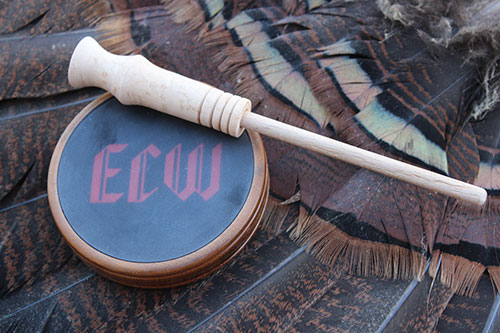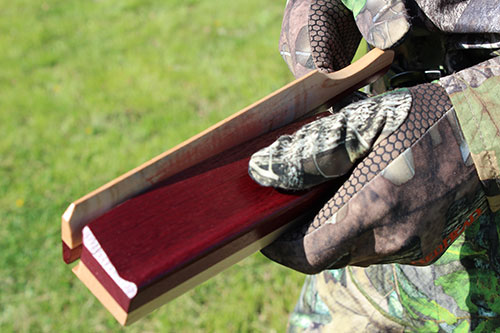Learning to be fluent in the language of spring is a lofty goal for a turkey hunter. But you have to start somewhere.
Text and photos by Jason Houser
Sitting on the edge of a grass field and calling spring turkeys is one of my favorite hunting experiences for my wife and I. When we can successfully call a gobbler within range, it is an accomplishment that many Americans will never be able to experience.

Friction calls and strikers can be made from a variety of materials, all of which make slightly different sounds. Photo credit Jason Houser.
Learning the language of spring turkeys is a lofty goal, and learning to be a skilled caller will not happen overnight. It will take practice and persistence to make it happen, and when it finally does, you will never forget it.
Calling a mature tom to your setup with yelps, purrs, cutts and clucks is a feeling of success that all turkey hunters strive for. Not knowing the proper techniques for how to use the different types of calls like box, friction and diaphragm mouth calls, might send a longbeard to the next county. With practice, any hunter can learn how to be a top-notch caller that makes other turkey hunters jealous.
Back to School
One of the best ways to learn how to call is to link up with an experienced caller. A knowledgeable turkey caller can teach you the best methods, explain what you are doing wrong, and when and where to use certain calling techniques.
Newcomers to the turkey calling game often yelp and cutt too slowly. Many experts believe that the rate or rhythm that a hen calls are much more important than the actual sounds that are made. Cutting, which is a series of quick clucks, is fast, aggressive and exciting. When a hen yelps, it is lively and faster than many new callers think it is.
When you team up with an experienced caller one of the main goals is to learn the proper rhythm to call. Listen to the cadence of calling they use and do your best to copy it. Do not be concerned about how your calling sounds. Even truly wild hens sometimes sound terrible in the woods. Learning the correct rhythm is far more important than sounding pitch perfect.
With all of the informational turkey hunting videos out there these days, callers have no excuse not to learn the rhythm that a turkey yelps, cutts, purrs and clucks. Many champion turkey callers also have CDs and digital downloads for sale featuring their calling techniques. These are a excellent ways to learn how to mimic the sounds of turkeys when you are trying to learn on your own. You can listen to them and practice in your car, at home, in the garage, while mowing the lawn, just about anywhere. The bottom line is that if you want to be a better turkey caller, you’ll need to practice every chance you get.
Box Calls
One of the easiest calls to learn to use is the box call. Even though it’s easy to use, it has probably resulted in more dead turkeys than any other call. But, one major disadvantage of the box call is that there is more movement involved than what many hunters prefer, especially when working gobblers into close range.
Right-handed hunters need to hold the bottom of the box call horizontally in their left hand. Do not hold the sides of the call, as this can ruin the sound. To make a yelp, slide the paddle part of the call toward your hands over the top edge of the box. To cluck on a box call, pop the paddle off of the call’s lip with short upward strokes. To mimic cutting, make fast clucks with sharply repeated pops along the lip.
Some turkey hunters prefer to hold a box call vertically and work the paddle against the surface. They believe that this method gives the them more control with their hands while producing a better sound. If you wish, you can even hold the paddle and move the box. Use what works best for you.
There are many styles of box calls available to hunters that make wonderful yelps, cutts, purrs, clucks, cackles and gobbles. No matter the design that you decide to use, always keep it chalked and dry so that it sounds natural.
Friction Calls
Friction calls, or what many hunters call slate calls, are a round call with a slate, glass, aluminum or other metal surface. Some slate calls have a combination of these materials, such as glass over slate. Each call needs a striker, a short rod to move against the call’s surface to create the friction — and sound.
Some call companies, like ECW Calls out of Roseville, Illinois, have two-sided turkey calls. Such a call will have two different calling surfaces, one on each side. The particular call that I use from ECW has textured glass on the front and Pennsylvania slate on the back. A call like this allows the hunter to make two distinctly different sounds without the need to purchase and carry separate calls.
Here’s how a right-handed hunter would use a friction call. Hold the friction call in your left hand with your fingers and thumb cupped around the outside edge. Hold the call waist high with a semi-firm hold. Position the striker between your first two fingers and thumb at a slight angle with your right hand. Hold the striker to the call’s surface about one-third of the way from the outside edge. To produce a yelp, apply pressure and put the striker in a counterclockwise motion, about the size of a nickel.
The yelp is a basic turkey sound, and probably the most commonly heard turkey vocalization. All male and female turkeys yelp. It sounds similar to its name.
When a turkey yelps, it is in a series of notes, mostly in a sequence of three to eight notes in a row. A turkey yelps to share its location with other birds. It means, “Hey everyone, I’m over here.”
Added finger pressure is required on the striker for making cutts. Hold the striker firmly at an angle so that the top is angled away from you when on the surface of the call. Quickly pull the striker toward your body with a good amount of pressure. Without raising the striker off of the call’s surface, slide the striker to the starting point and repeat the process several times. This will make a loud cutting sound that will make a mature gobbler lovesick for a hen.
When a hen uses single-note clucks, these have a similar meaning to when a tom uses them, and are often in conjunction with feeding or just moving around the area. Sometimes soft clucking can be confused with a putt.
Cutting is a series of loud and fast clucks mixed in with some yelps. It is used when a hen is fired up. If a gobbler has gone silent, many times using this call will work to get a response. Be careful not to overdo it, though, because sometimes a silent tom may just be around the corner and cutting might just be too aggressive for him, depending on the scenario.
Holding the striker too tight is something that many hunters have trouble with when using a friction call. This will cause a squeaky, high-pitched noise. Instead, try to hold the striker loose enough that it will allow a natural-sounding yelp. With a little practice, you will begin to get the feel of how tight to hold the striker.
Just like all friction calls’ surfaces are not all made from the same materials, neither are the strikers. They can be made from wood, carbon, plastic and aluminum. Try out a few different strikers until you find one that you are comfortable with. Many calls come with a striker in the package that will work just fine with that call.
Mouth Calls
Diaphragms, or mouth calls, are the toughest to master, but because no hand movement is involved they are one of the favorites among turkey hunters.
Beginners should start with a one- or two-reed model. They are easier to learn than three- or four-reed diaphragms. Talk to other hunters that are proficient with mouth calls. They can tell you which one is best for a beginner.

A vital key to consistently successful turkey hunting begins with knowing how to properly call. Photo credit Jason Houser.
Find a diaphragm that fits snugly inside your mouth. If it’s too tight in your mouth, lightly trim off the edges. Keep in mind that a little trimming can go a long way.
The best advice that I can give you about mouth calls is to practice, practice, practice, and then practice some more with a call that fits well and is easy to use. The call goes in your mouth with the horseshoe opening toward your lips. If you are using a call with more than one reed, place the longest reed on top. Now press the back of your tongue on the call frame near the edge. The call should be firm against the roof of your mouth.
Blow a hissing sound of air along your tongue’s surface like you are saying “shhh.” This will produce a squeal-like sound. To make the two-note sound of the yelp, make the squealing sound then drop your jaw to lower your tongue pressure as you are blowing. It should sound like you are saying “shh-awk.” After you have mastered that, speed up the two-note call to make a yelp. Now put the calls into a rhythm to make a series of yelps. Practice makes perfect.
Don’t get stuck on just one type of call. It’s good strategy to carry a variety with you to the woods. If a gobbler will not respond to a friction call, try using a mouth call. The change of calls and differences in their sound might be all it takes to work a longbeard in for a shot.
The most important thing is to practice until you are effective with the call, no matter what type it is. The ability to call correctly and entice a gobbler within range is as exciting as it gets. There are many, many brands of high-quality turkey calls and styles to choose from these days. It might take a little time to find the call that is right for you, but don’t settle for anything less than what works and sounds the best.



